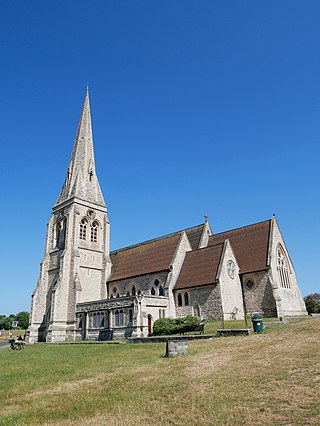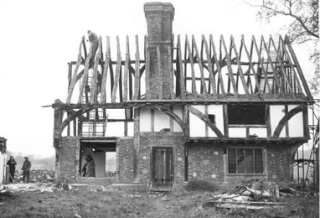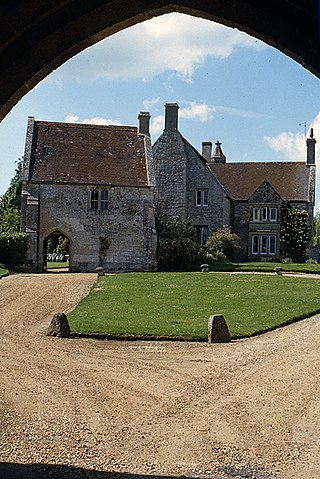Related Research Articles

Blackheath is an area in Southeast London, straddling the border of the Royal Borough of Greenwich and the London Borough of Lewisham. It is located 1-mile (1.6 km) northeast of Lewisham, 1.5 miles (2.4 km) south of Greenwich and 6.4 miles (10.3 km) southeast of Charing Cross, the traditional centre of London.

Greenwich is a town in south-east London, England, within the ceremonial county of Greater London. It is situated 5.5 miles (8.9 km) east-southeast of Charing Cross.

Inigo Jones was the first significant architect in England and Wales in the early modern period, and the first to employ Vitruvian rules of proportion and symmetry in his buildings. As the most notable architect in England and Wales, Jones was the first person to introduce the classical architecture of Rome and the Italian Renaissance to Britain. He left his mark on London by his design of single buildings, such as the Queen's House which is the first building in England designed in a pure classical style, and the Banqueting House, Whitehall, as well as the layout for Covent Garden square which became a model for future developments in the West End. He made major contributions to stage design by his work as theatrical designer for several dozen masques, most by royal command and many in collaboration with Ben Jonson.

Greenwich Park is a former hunting park in Greenwich and one of the largest single green spaces in south-east London. One of the Royal Parks of London, and the first to be enclosed, it covers 74 hectares, and is part of the Greenwich World Heritage Site. It commands views over the River Thames, the Isle of Dogs and the City of London.

The Palace of Placentia, also known as Greenwich Palace, was an English royal residence that was initially built by Humphrey, Duke of Gloucester, in 1443. The palace was a place designed for pleasure, entertainment and an escape from the city. It was located at Greenwich on the south bank of the River Thames, downstream from London. On a hill behind the palace he built Duke Humphrey's Tower, later known as Greenwich Castle; it was subsequently demolished to make way for the Royal Observatory, Greenwich, which survives. The original river-side residence was extensively rebuilt around 1500 by Henry VII. A detached residence, the Queen's House, was built on the estate in the early 1600s and also survives. In 1660, the main palace was demolished by Charles II to make way for a proposed new palace, which was never constructed. Nearly forty years later, the Greenwich Hospital was built on the site.
George Smith was an English architect and surveyor of the early 19th century, with strong connections with central and south-east London.

Ranger's House is a medium-sized red brick Georgian mansion in the Palladian style, adjacent to Greenwich Park in the south east of London. It is situated in Blackheath and backs directly onto Greenwich Park. Previously known as Chesterfield House, its current name is associated with the Ranger of Greenwich Park, a royal appointment; the house was the Ranger's official residence for most of the 19th century. It is a Grade I listed building. There is a rose garden behind it, and since 2002 it has housed the Wernher Collection of art.
Simon John Thurley, is an English academic and architectural historian. He served as Chief Executive of English Heritage from April 2002 to May 2015. In April 2021, he became Chair of the National Lottery Heritage Fund.

The Church Army Chapel at Vanbrugh Park, Blackheath, Greater London, designed by project architect E.T. Spashett for Austin Vernon & Partners, opened in 1965 by Princess Alexandra and consecrated by Michael Ramsey, is a locally listed building of outstanding architectural significance, and is notable for originally having had the tallest sectional aluminium spire of its time, and for being one of the earliest 20th-century chapels of modern design to have been conceived with a central altar. It is now part of Blackheath High School.

The Wealden hall house is a type of vernacular medieval timber-framed hall house traditional in the south east of England. Typically built for a yeoman, it is most common in Kent and the east of Sussex but has also been built elsewhere. Kent has one of the highest concentrations of such surviving medieval timber-framed buildings in Europe.
Warwick James Rodwell is an archaeologist, architectural historian and academic. He was lately Visiting Professor in the Department of Archaeology, University of Reading, and is Consultant Archaeologist to Westminster Abbey, where he is also a member of the College of St Peter in Westminster. He is the author of many books and articles, including the standard textbook on church archaeology. He is a Fellow of the Society of Antiquaries of London, the Society of Antiquaries of Scotland and the Royal Historical Society.
William Abel Pantin was an historian of medieval England who spent most of his academic life at the University of Oxford.

Michael James Swanton is a British historian, linguist, archaeologist and literary critic, specialising in the Anglo-Saxon period and its Old English literature.

Vanbrugh Castle is a house designed and built by John Vanbrugh for his own family, located on Maze Hill on the eastern edge of Greenwich Park in London, to the north of Blackheath, with views to the west past the Old Royal Naval College at Greenwich down to the Thames reaching as far as the Houses of Parliament.

St John's Blackheath is an all age Anglican church in the Vanbrugh Park area of Blackheath, part of the Royal Borough of Greenwich in southeast London, England. Built in the 1850s to the design of architect Arthur Ashpitel, it provided "an important visual and spiritual focus" to a rapidly growing high-class residential area. The church has an Evangelical character. There are two services on a Sunday. St John's Blackheath has thriving children's groups and youth groups. Their vision is to be A church for all ages, committed to growing in outreach, discipleship and the next generation.

Neil Biron Rhind is an English journalist, writer and an authority on the social and historical development of Blackheath and surrounding areas of south east London.
Kathryn A. Morrison is a British architectural historian.

Place Farm is a complex of medieval buildings in the village of Tisbury, Wiltshire, England. They originally formed a grange of Shaftesbury Abbey. The farmhouse, the inner and outer gatehouses and the barn, reputedly the largest in England, are all Grade I listed buildings.
Peter Draper, is an architectural historian who has, over his long academic career, specialised in medieval architecture with a particular interest in English ecclesiastical building, primarily cathedrals, and the relationship between the architecture and its social, political and liturgical functions. Latterly his research has extended to Islamic architecture and its influence on Western traditions. He is Professor emeritus and an honorary life member of Birkbeck College, University of London where he is currently Visiting Professor in the History of Architecture. He has published numerous articles and books including The Formation of English Gothic : Architecture and Identity, for which he won two prestigious awards; the Spiro Kostof Book Award from the Society of Architectural Historians in 2008 and the Alice Davis Hitchcock Medallion in 2009, awarded by the Society of Architectural Historians of Great Britain.
References
- ↑ Member of the Royal Archaeological Institute
- ↑ Quiney, Anthony (12 October 1986). "House and home a history of the small English house". British Broadcasting Corp.
- ↑ Anthony Quiney (11 January 2004). "Town Houses of Medieval Britain – Quiney, Anthony – Yale University Press". Yalepress.yale.edu. Retrieved 9 September 2013.
- ↑ "Society of Antiquaries of London – List of Fellows". Sal.org.uk. Archived from the original on 9 July 2012. Retrieved 9 September 2013.
- ↑ "Ginnie Hole". IMDb.
- ↑ Quiney, Anthony (2009). A Year in the Life of Greenwich Park. London: Frances Lincoln Publishers. ISBN 978-0-7112-2871-9.